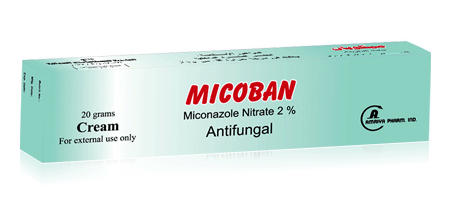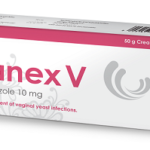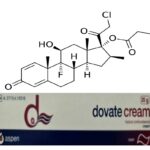How Long Does Micoban Cream Take To Work?

Micoban topical cream is an antifungal medicine that contains Miconazole 2%. Miconazole is an azole antifungal that works by preventing the growth of fungus. Micoban is used to treat skin infections such as athlete’s foot, jock itch, ringworm, and other fungal skin infections (candidiasis). This medication is also used to treat a skin condition known as pityriasis (tinea versicolor), a fungal infection that causes a lightening or darkening of the skin of the neck, chest, arms, or legs. This cream is also used to treat vaginal infections caused by fungi.
Miconazole is in the imidazole family of medications. Micoban works by decreasing the ability of fungi to make ergosterol, an important part of their cell membrane. Miconazole was patented in 1968 and approved for medical use in 1971. It is on the World Health Organization’s List of Essential Medicines.
How to use Micoban cream
Fungal infections of the skin: Apply some Micoban cream to the lesions two times daily. Rub the cream into the skin with your finger until it has fully penetrated. The duration of therapy varies from 2 to 6 weeks depending on the localization and the severity of the lesion. Treatment should be continued at least one week after disappearance of all signs and symptoms.
Nail infections: Apply the Micoban cream once or twice daily to the lesions. Treatment should be prolonged for 10 days after all lesions have disappeared to prevent relapse.
If you have itching/burning around the outside of the vagina (vulva), apply the skin cream to that area usually twice a day for no more than 7 days.
How long does Micoban cream take to work?
Depending on the type, duration of the infection and your immune status, you should begin to feel better during the first three days of treatment with Micoban cream. The CDC recommends 7-day treatment for pregnant women and diabetic women (consult a doctor before use). If your symptoms do not improve or get worse, call your doctor.
What are the side effects of Micoban topical cream?
Micoban topical cream can cause side effects such as burning, stinging, swelling, irritation, redness, pimple-like bumps, tenderness, or flaking of the treated skin. If any of these effects persist or worsen, notify your doctor or pharmacist promptly. If your doctor has directed you to use this Micoban topical cream, remember that he or she has judged that the benefit to you is greater than the risk of side effects. Many people using this medication do not have serious side effects.
Tell your doctor right away if any of these unlikely but serious side effects occur: blistering, oozing, open sores. A very serious allergic reaction to this drug is rare. However, seek immediate medical attention if you notice any symptoms of a serious allergic reaction, including: rash, itching/swelling (especially of the face/tongue/throat), severe dizziness, trouble breathing.
This is not a complete list of possible side effects. If you notice other effects not listed above, contact your doctor or pharmacist. In the US -Call your doctor for medical advice about side effects. You may report side effects to FDA at 1-800-FDA-1088 or at www.fda.gov/medwatch.In Canada – Call your doctor for medical advice about side effects. You may report side effects to Health Canada at 1-866-234-2345.
Micoban Safety Information
Before using Micoban topical cream, tell your doctor or pharmacist if you are allergic to it; or to other azole antifungals such as clotrimazole, econazole, or ketoconazole; or if you have any other allergies. This product may contain inactive ingredients, which can cause allergic reactions or other problems. Talk to your pharmacist for more details. Before using this medication, tell your doctor or pharmacist your medical history. During pregnancy, this medication should be used only when clearly needed. Discuss the risks and benefits with your doctor. It is not known whether this drug passes into breast milk. Consult your doctor before breast-feeding.
Does Micoban interact with any medication?
Your doctor or pharmacist may already be aware of any possible drug interactions and may be monitoring you for them. Do not start, stop, or change the dosage of any medicine before checking with your doctor or pharmacist first. Before using this medication, tell your doctor or pharmacist of all prescription and nonprescription/herbal products you may use. Keep a list of all your medications with you, and share the list with your doctor and pharmacist.
What should I know about storage and disposal of Micoban?
Keep this medication in the container it came in, tightly closed, and out of reach of children. Store it at room temperature and away from excess heat and moisture (not in the bathroom).
It is important to keep all medication out of sight and reach of children as many containers (such as weekly pill minders and those for eye drops, creams, patches, and inhalers) are not child-resistant and young children can open them easily. To protect young children from poisoning, always lock safety caps and immediately place the medication in a safe location – one that is up and away and out of their sight and reach. http://www.upandaway.org
Unneeded medications should be disposed of in special ways to ensure that pets, children, and other people cannot consume them. However, you should not flush this medication down the toilet. Instead, the best way to dispose of your medication is through a medicine take-back program. Talk to your pharmacist or contact your local garbage/recycling department to learn about take-back programs in your community. See the FDA’s Safe Disposal of Medicines website (http://goo.gl/c4Rm4p) for more information if you do not have access to a take-back program.





